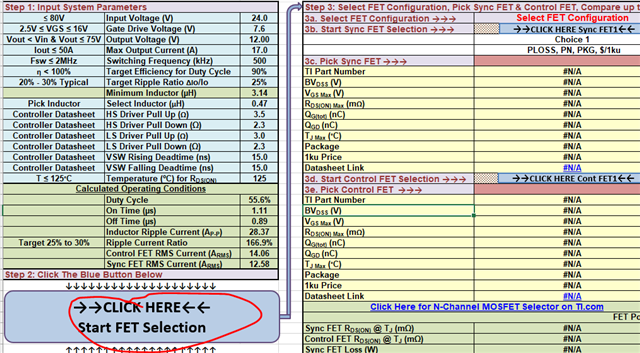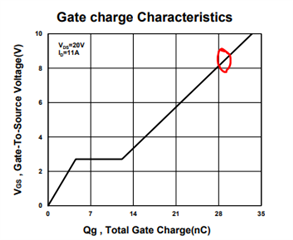Other Parts Discussed in Thread: LM5143,
Hi
I can't get any result on the right side after I click red circle,
Is anything wrong?

This thread has been locked.
If you have a related question, please click the "Ask a related question" button in the top right corner. The newly created question will be automatically linked to this question.
Hello Fred
Minimum L is 3.14uH but you selected 0.487uH. The tool stops working if a wrong input is entered.

- Eric Lee
Hi Eric,
below is condition and spec, attached is the MOS datasheet,
Vin=24, vout=12 , TDC=17A , 500KHz
would you help me check if they can use two parallel MOS at high side?

Is there a large switching loss due to large gate charge here (40nC)
Hello Fred
No, you cannot use it. MOFET gate driving current is 60mA (30nC x 4 x 500kHz=60mA) which is twice more than 30mA VCC current limit.
LM5143 is a dual-phase buck controller which is designed to handle high current/high power. And its VCC regulator can handle much more current. Please consider to use LM5143.
- Eric Lee
Hi Eric,
1. I think the equation you show have some problem, since my Vin is 24V>VCC,
so the Vg should be 7.6V instead of 4V and driving current limit should be 42mA instead of 30mA which is the spec when Vin<VCC.
am I correct?
2. since this MOS Qg is around 28nC when Vg is 7.6V, (see datasheet)
what if I use only one MOS (PK6A6BA) instead and change frequency to 150kHz (28nCx7.6x150kHz=32mA <42mA) ?
can I pass thermal if my driving current is below maximum 42mA?
please help evaluate, thanks
Hello Fred
1, 60mA is the current which should be supplied by the VCC regulator. I = Q x Fsw , and I = 30nC x 4pcs x 500kHz since you are using 4 MOSFETs.
2. 30nC is the gate charge at the maximum VCC regulation which is 8.2V

The driving current should be less than 30mA which is the minimum of the VCC regulator current limit.

- Eric Lee
Hi Eric,
Sorry, I thought 30mA was the case when Vin and VCC is below 4V..., which turn out not to be true.
1. so again what if I use only one MOS at high side and reduce the frequency to the half , 22.5mA=30nCx3pcsx250KHz < 30mA.
Is this OK?
2. and what would happen if the driving current is above the sourcing current limit of LM25117 (30mA) ?
would you elaborate on what would happen on the internal LDO? and how is that related to the thermal of the high side MOS?
Hello Fred
1.Then, the VCC current limit issue is resolved, but the high-side MOSFET temperature will increase.
2. If the driving current is higher than the VCC current limit, the VCC pin voltage starts dropping, VCC UVLO is triggered, and eventually shuts down the device.
- Eric Lee
Hi Eric,
I see, thanks for explanation.
speaking of MOS temperature,
would you help evaluate If 250khz can avoid thermal issue in only one high side MOS condition?
I've upload the datasheet above.
and I don't think use other IC like LM5143 can make thermal of MOS any better, right?
Hello Fred
- Eric Lee
Hi Eric,
1. I see that thermal resistance varies, but based on the existing thermal resistance RJA that datasheet provide , can you help evaluate if the MOS pass the thermal or not?
2. the other question is if I only use one LM5143, is the thermal situation of MOS same as now or still better?
thanks
Regards,
Fred
Hello Fred
1. What's the maximum ambient temperature ?
2. LM5143 is a dual-channel controller. By using LM5143, you naturally have to design two 2-phase buck and use two high-side MOSFETs. Then, the power loss will be split into those two high-side MOSFETs.
- Eric Lee
Hi Eric,
thanks for your calculation,
We've change the MOS as below,
the Rds_on is now become 2ohm. the PDC should be 1/4 , which is around 0.56W
As for PSW , the Qg is also drastically reduced , which reduce the tr and tf as well (not sure what the exact number)
through my rough calculation, the Tj is sure below 150C
I believe this can pass with more confidence, would you help check again with new high side MOS?
thanks a lot.
Hi Eric,
again, thanks for the support.
outcome looks OK .
one last question is how did you get 1.3 nonlinear factor and tr and tf ?
like how did you know tr=10ns ?
Hello Fred
- Eric Lee